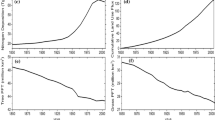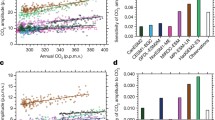Abstract
Increasing concentrations of atmospheric CO2 influence climate, terrestrial biosphere productivity and ecosystem carbon storage through its radiative, physiological and fertilization effects. In this paper, we quantify these effects for a doubling of CO2 using a low resolution configuration of the coupled model NCAR CCSM4. In contrast to previous coupled climate-carbon modeling studies, we focus on the near-equilibrium response of the terrestrial carbon cycle. For a doubling of CO2, the radiative effect on the physical climate system causes global mean surface air temperature to increase by 2.14 K, whereas the physiological and fertilization on the land biosphere effects cause a warming of 0.22 K, suggesting that these later effects increase global warming by about 10 % as found in many recent studies. The CO2-fertilization leads to total ecosystem carbon gain of 371 Gt-C (28 %) while the radiative effect causes a loss of 131 Gt-C (~10 %) indicating that climate warming damps the fertilization-induced carbon uptake over land. Our model-based estimate for the maximum potential terrestrial carbon uptake resulting from a doubling of atmospheric CO2 concentration (285–570 ppm) is only 242 Gt-C. This highlights the limited storage capacity of the terrestrial carbon reservoir. We also find that the terrestrial carbon storage sensitivity to changes in CO2 and temperature have been estimated to be lower in previous transient simulations because of lags in the climate-carbon system. Our model simulations indicate that the time scale of terrestrial carbon cycle response is greater than 500 years for CO2-fertilization and about 200 years for temperature perturbations. We also find that dynamic changes in vegetation amplify the terrestrial carbon storage sensitivity relative to a static vegetation case: because of changes in tree cover, changes in total ecosystem carbon for CO2-direct and climate effects are amplified by 88 and 72 %, respectively, in simulations with dynamic vegetation when compared to static vegetation simulations.







Similar content being viewed by others
References
Bala G, Caldeira K, Mirin A, Wickett M, Delire C (2005) Multiceutury changes to the global climate and carbon cycle: results from a coupled climate and carbon cycle model. J Clim 18(21):4531–4544
Bala G et al (2006) Biogeophysical effects of CO2 fertilization on global climate. Tellus Ser B Chem Phys Meteorol 58(5):620–627
Betts RA et al (1997) Contrasting physiological and structural vegetation feedbacks in climate change simulations. Nature 387(19):796–799
Betts RA et al (2004) The role of ecosystem-atmosphere interactions in simulated Amazonian precipitation decrease and forest dieback under global climate warming. Theor Appl Climatol 78(1–3):157–175
Betts RA et al (2007) Projected increase in continental runoff due to plant responses to increasing carbon dioxide. Nature 448(7157):1037–1041
Boer GJ, Arora V (2009) Temperature and concentration feedbacks in the carbon cycle. Geophys Res Lett 36:L02704. doi:10.1029/2008GL036220
Bonan GB, Levis S (2010) Quantifying carbon-nitrogen feedbacks in the Community Land Model (CLM4). Geophys Res Lett 37:L0740. doi:10.1029/2010GL042430
Boone RD, Nadelhoffer KJ, Canary JD, Kaye JP (1998) Roots exert a strong influence on the temperature sensitivity of soil respiration. Nature 396(6711):570–572
Cao L, Bala G, Caldeira K, Nemani R, Ban-Weiss G (2010) Importance of carbon dioxide physiological forcing to future climate change. Proc Natl Acad Sci USA 107(21):9513–9518
Castillo CKG, Levis S, Thornton P (2011) Evaluation of the new cndv option of the community land model: effects of dynamic vegetation and interactive nitrogen on CLM4 means and variability. J Clim 25:3702–3714
Collatz GJ, Ribas-Carbo M, Berry JA (1992) Coupled photosynthesis-stomatal conductance model for leaves of C4 plants. Aust J Plant Physiol 19(5):519–538
Cox PM et al (1999) The impact of new land surface physics on the GCM simulation of climate and climate sensitivity. Clim Dyn 15(3):183–203
Cox PM, Betts RA, Jones CD, Spall SA, Totterdell IJ (2000) Acceleration of global warming due to carbon-cycle feedbacks in a coupled climate model. Nature 408(6809):184–187
Cramer W et al (2001) Global response of terrestrial ecosystem structure and function to CO2 and climate change: results from six dynamic global vegetation models. Glob Change Biol 7(4):357–373
Curtis PS (1996) A meta-analysis of leaf gas exchange and nitrogen in trees grown under elevated carbon dioxide. Plant, Cell Environ 19(2):127–137
Frank CD, Esper J, Raible CC, Buntgen U, Trouet V, Stosker B, Joos F (2010) Ensemble reconstruction constraints on the global carbon cycle sensitivity to climate. Nature 463:527–530
Friedlingstein P et al (2001) Positive feedback between future climate change and the carbon cycle. Geophys Res Lett 28(8):1543–1546
Friedlingstein P, Dufresne JL, Cox PM, Rayner P (2003) How positive is the feedback between climate change and the carbon cycle? Tellus Ser B Chem Phys Meteorol 55(2):692–700
Friedlingstein P et al (2006) Climate-carbon cycle feedback analysis: results from the (CMIP)-M-4 model intercomparison. J Clim 19(14):3337–3353
Gedalof Z, Berg AA (2010) Tree ring evidence for limited direct CO(2) fertilization of forests over the 20th century. Glob Biogeochem Cycles 24:GB3027. doi:10.1029/2009GB003699
Gedney N et al (2006) Detection of a direct carbon dioxide effect in continental river runoff records. Nature 439(7078):835–838
Gent PR et al (2011) The Community Climate System Model Version 4. J Clim 24(19):4973–4991
Gillett NP, Arora VK, Zickfeld K, Marshall SJ, Merryfield AJ (2011) Ongoing climate change following a complete cessation of carbon dioxide emissions. Nat Geosci 4(2):83–87
Good P, Jones C, Jason L, Betts R, Booth B, Huntingford C (2011) Quantifying environmental drivers of future tropical forest extent. J Clim 24:1337–1349
Govindasamy B et al (2005) Increase of carbon cycle feedback with climate sensitivity: results from a coupled climate and carbon cycle model. Tellus Ser B Chem Phys Meteorol 57(2):153–163
House JI, Prentice IC, Ramankutty N, Houghton RA, Heimann M (2003) Reconciling apparent inconsistencies in estimates of terrestrial CO2 sources and sinks. Tellus Ser B Chem Phys Meteorol 55(2):345–363
Jones C, Jason L, Spencer L, Betts R (2009) Committed terrestrial ecosystem changes due to climate change. Nat Geosci 2:484–487
Jones C, Jason L, Spencer L, Betts R (2010) Role of terrestrial ecosystems in determining CO2 stbilization and recovery behaviour. Tellus Ser B Chem Phys Meteorol 62(5):682–699
Joos F, Sarmiento JL, Siegenthaler U (1991) Estimates of the effect of Southern-Ocean iron fertilization on atmospheric CO2 concentrations. Nature 349(6312):772–775
Kloster S et al (2010) Fire dynamics during the 20th century simulated by the Community Land Model. Biogeosciences 7(6):1877–1902
Lawrence DM et al (2011) Parameterization improvements and functional and structural advances in version 4 of the Community Land Model. J Adv Model Earth Syst 3:1–29. doi:10.1029/2011MS000045
Le Quere C et al (2009) Trends in the sources and sinks of carbon dioxide. Nat Geosci 2(12):831–836
Levis S, Bonan GB, Vertenstein M, Oleson KW (2004) The Community Land Model’s dynamic global vegetation model (CLM-DGVM): technical description and user’s guide. NCAR, Boulder
Lloyd J, Taylor JA (1994) On the temperature-dependence of soil respiration. Funct Ecol 8(3):315–323
Matthews HD (2007) Implications of CO(2) fertilization for future climate change in a coupled climate-carbon model. Glob Change Biol 13(5):1068–1078
Matthews HD, Weaver AJ, Meissner KJ (2005) Terrestrial carbon cycle dynamics under recent and future climate change. J Clim 18(10):1609–1628
Nadelhoffer KJ et al (1999) Nitrogen deposition makes a minor contribution to carbon sequestration in temperate forests. Nature 398(6723):145–148
Norby RJ et al (2005) Forest response to elevated CO2 is conserved across a broad range of productivity. Proc Nat Acad Sci USA 102(50):18052–18056
Oleson KW et al (2008) Improvements to the Community Land Model and their impact on the hydrological cycle. J Geophys Res 113:G01021. doi:10.1029/2007JG000563
Oleson KW, Bonan GB, Feddema JJ, Vertenstein M, Kluzek E (2010) Technical description of an urban parameterization for the Community Land Model (CLM). NCAR, Boulder
Owensby CE, Ham JM, Knapp AK, Auen LM (1999) Biomass production and species composition change in a tallgrass prairie ecosystem after long-term exposure to elevated atmospheric CO2. Glob Change Biol 5(5):497–506
Plattner GK et al (2008) Long-term climate commitments projected with climate-carbon cycle models. J Clim 21(12):2721–2751
Prentice IC et al (2001) The carbon cycle and atmospheric carbon dioxide. In: Houghton JT et al (eds) Climate change 2001: the scientific basis. Cambridge University Press, New York
Qian T, Dai A, Trenberth KE, Oleson KW (2006) Simulation of global land surface conditions from 1948 to 2004. Part I: forcing data and evaluations. J Hydrometeorol 7:953–975
Randerson JT et al (2009) Systematic assessment of terrestrial biogeochemistry in coupled climate-carbon models. Glob Change Biol 15(10):2462–2484
Schimel D et al (1995) CO2 and the carbon cycle. In: Houghton JT et al (eds) Climate change 1994, radiative forcing of climate change and evaluation of the IPCC IS92 emission scenarios. Cambridge University Press, New York
Schuur EAG et al (2008) Vulnerability of permafrost carbon to climate change: implications for the global carbon cycle. Bioscience 58(8):701–714
Schuur EAG et al (2009) The effect of permafrost thaw on old carbon release and net carbon exchange from tundra. Nature 459(7246):556–559
Sellers PJ et al (1996) Comparison of radiative and physiological effects of doubled atmospheric CO2 on climate. Science 271(5254):1402–1406
Sitch S et al (2008) Evaluation of the terrestrial carbon cycle, future plant geography and climate-carbon cycle feedbacks using five Dynamic Global Vegetation Models (DGVMs). Glob Change Biol 14(9):2015–2039
Thompson SL et al (2004) Quantifying the effects of CO2-fertilized vegetation on future global climate and carbon dynamics. Geophys Res Lett 31(23):L23211. doi:10.1029/2004GL021239
Thornton PE, Lamarque JF, Rosenbloom NA, Mahowald NM (2007) Influence of carbon-nitrogen cycle coupling on land model response to CO(2) fertilization and climate variability. Glob Biogeochem Cycles 21:GB4018. doi:10.1029/2006GB002868
Thornton PE et al (2009) Carbon-nitrogen interactions regulate climate-carbon cycle feedbacks: results from an atmosphere-ocean general circulation model. Biogeosciences 6(10):2099–2120
Zaehle S, Friedlingstein P, Friend AD (2010) Terrestrial nitrogen feedbacks may accelerate future climate change. Geophys Res Lett 37:L01401. doi:10.1029/2009GL041345
Zeng N, Qian HF, Munoz E, Iacono R (2004) How strong is carbon cycle-climate feedback under global warming? Geophys Res Lett 31:L20203. doi:10.1029/2004GL020904
Zickfeld K, Eby M, Matthews HD, Schmittner A, Weaver AJ (2011) Nonlinearity of carbon cycle feedbacks. J Clim 24(16):4255–4275
Zwiers F, von Storch H (1995) Taking serial correlation into account in tests of the mean. J Clim 8:336–351
Acknowledgments
We thank Drs. Chris Jones and Sam Levis for their critical comments and suggestions which helped us to improve the original manuscript substantially. Financial support from Department of Science and Technology under the grant DST 0948 is gratefully acknowledged. Dr. Devaraju and Mr. Krishna are supported by the Divecha Center for Climate Change.
Author information
Authors and Affiliations
Corresponding author
Electronic supplementary material
Below is the link to the electronic supplementary material.
Rights and permissions
About this article
Cite this article
Bala, G., Krishna, S., Narayanappa, D. et al. An estimate of equilibrium sensitivity of global terrestrial carbon cycle using NCAR CCSM4. Clim Dyn 40, 1671–1686 (2013). https://doi.org/10.1007/s00382-012-1495-9
Received:
Accepted:
Published:
Issue Date:
DOI: https://doi.org/10.1007/s00382-012-1495-9




